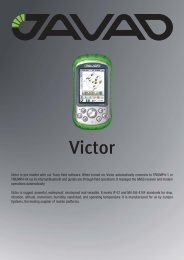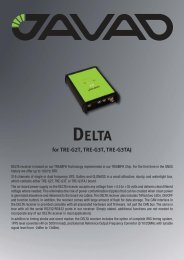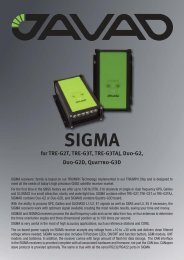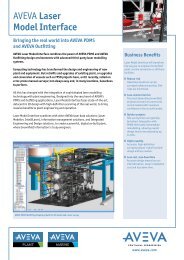Franz-Klein-Gasse 1, A-1190 Wien, Ãsterreich Vienna Institute for ...
Franz-Klein-Gasse 1, A-1190 Wien, Ãsterreich Vienna Institute for ...
Franz-Klein-Gasse 1, A-1190 Wien, Ãsterreich Vienna Institute for ...
You also want an ePaper? Increase the reach of your titles
YUMPU automatically turns print PDFs into web optimized ePapers that Google loves.
VIA<strong>Vienna</strong> <strong>Institute</strong> <strong>for</strong> Archaeological Science<strong>Franz</strong>-<strong>Klein</strong>-<strong>Gasse</strong> 1, A-<strong>1190</strong> <strong>Wien</strong>, ÖsterreichAusgabe 02/2008Auflage: 500Herausgeber und MedieninhaberVIAS, Universität <strong>Wien</strong>www.univie.ac.at/viasRedaktionMatthias KuceraWolfgang NeubauerVIAS, Universität <strong>Wien</strong>DruckFerdinand Berger & Söhne GmbHPulverturmgasse 3A - 1090 <strong>Wien</strong>www.berger.atLayout und DTPKaroline Taschnerwww.linity.atAll aerial photographs:© luftbildarchivUr-und Frühgeschichte Universität <strong>Wien</strong>Photos & Graphik:Michael Doneus, Herbert Durdis, Martin Fera, Kurt Hofinger,Karoline Kastowsky, Matthias Kucera, Wolfgang Lobisser, Klaus Löcker,Wolfgang Neubauer, Oliver Rachbauer, Andreas Rausch,Wolfgang Reichmann, Karoline Taschner, Toledo i DertscheiCover:Aerial photograph and digital terrain model derivedfrom an airborne laserscan (see Doneus M. and Neubauer W.)1
VIAS - <strong>Vienna</strong> <strong>Institute</strong> <strong>for</strong> Archaeological ScienceDirectorateO. Univ. Prof. Dr. Manfred Bietakmanfred.bietak@univie.ac.atAss.-Prof. Dr. Irmgard Heinirmgard.hein@univie.ac.atSecretariatGabriele Sentallgabriele.sentall@univie.ac.atArchäoastronomieDr. Georg Zottigeorg.zotti@univie.ac.atDendrochronologieDr. Otto Cichockiotto.cichocki@univie.ac.atKeramikanalysenDr. Hajnalka Heroldhajnalka.herold@univie.ac.atArchäobotanikDr. Ursula Thanheiserursula.thanheiser@univie.ac.atExperimentelle ArchäologieMag. Wolfgang Lobisserwolfgang.lobisser@univie.ac.atLuftbildarchäologieMag. Dr. Gabriele Scharrer-Liškagabriele.scharrer@univie.ac.atArchäometallurgieMag. Ing. Mathias Mehofermathias.mehofer@univie.ac.atFeinschmiedetechnikMag. Dr. Birgit Bühlerbirgit.buehler@univie.ac.atMaterialanalyse, WissenschaftstheorieMag. Matthias Kuceramatthias.kucera@univie.ac.atArchäozoologieDr. Günther Karl Kunstguenther.karl.kunst@univie.ac.atGeophysikDr. Wolfgang Neubauerwolfgang.neubauer@univie.ac.at2
Interdisziplinäre Forschungsplatt<strong>for</strong>m für Archäologie der Universität <strong>Wien</strong> VIACONTENTS:040611151824EDITORIALManfred Bietak, Wolfgang NeubauerThe prehistoric <strong>for</strong>tifiedsettlement Schwarzenbach-BurgA long term interdisciplinaryresearch project of VIASWolfgang NeubauerWhen archaeology became digitalDocumentation of Trench 3at Schwarzenbach-BurgKlaus LöckerThe Bronze Age settlementResults of the excavation trench 3 + 4at Schwarzenbach-BurgOliver RachbauerArtificial Cranial De<strong>for</strong>mationin a Migration Period Burialfrom Schwarzenbach-BurgDoris Pany, Karin Wiltschke-SchrottaArchäometrische Analysen LaTÈnezeitlichergraphithaltiger Keramikvon Schwarzenbach (NÖ)Hajnalka Herold374553606775Wood and IronTHe most important rawmaterials of the CeltsWolfgang LobisserDigital recording ofstratigraphic archaeologicalexcavations usingterrestrial 3D laser scannersWolfgang Neubauer, Michael DoneusAerial Archaeology andAirborne Laser-Scanningat the Iron Age hill<strong>for</strong>tSchwarzenbach-BurgMichael Doneus, Wolfgang NeubauerThe CelticNight ProjectEuropean Researchers´ Night 2007at Schwarzenbach-BurgWolfgang Neubauer, Matthias Kucera, Wolfgang LobisserResearchers are among usThe Celticnight ReportMatthias Kucera, Wolfgang Neubauer, Wolfgang LobisserEvaluation report of the Celticnight 2007Karin Wiltschke-Schrotta31From Practice to TheoryExpanding the stratigraphicrecording into real 3DWolfgang Neubauer83The gold belt ornaments fromBrestovac – TechnologicalstudiesBirgit Bühler3
Interdisziplinäre Forschungsplatt<strong>for</strong>m für Archäologie der Universität <strong>Wien</strong> VIADigital recording of stratigraphic archaeological excavationsusing terrestrial 3D laser scannersWolfgang Neubauer, Michael DoneusAny archaeological site shows a stratification <strong>for</strong>med bysingle 3D volumes, the deposits and specific 3D surfaces ofhuman origin as pits, ditches or wall-surfaces known as theunits of stratification. Excavation <strong>for</strong>ms the main data retrievalprocess in field archaeology - a destructive process tobe documented in three dimensions. To fully reconstruct thepart of the site destroyed by excavation these units have tobe documented in 3D. The outstanding importance of a 3Ddocumentation of the stratification by the means of the singlesurfaces indicates the use of terrestrial 3D laser scannerscombined with digital imagery as a standard documentationtool. They provide high topographic detail and texture<strong>for</strong> the efficient digital documentation and monitoring ofthe excavation process. This monitoring demand opens awide field of future development – hardware and software- to integrate laser scanners in the daily archaeologicalwork flow.3D Laser Scanner Riegl LMS Z210 as first in use in Schwarzenbach in2002.Terrestrial laser scanning has been successfully applied todocument historic buildings or archaeological featureslike walls, columns, monumental statues all over theworld. Our own projects scanning the pyramids of Gizaand the Sphinx (ViaVIAS 01/2007), the Celsus Libraryat Ephesos or the monumental graves of the Tang emperors,just to mention a few, proofed this technique tobe able to collect reliable, high resolution data of suchmonuments in a short time. More specific applicationsinclude the documentation of caves or mines as the3D Laser Scanner Riegl LMS Z420i overlooking a valley on Crimea,Ukraine.oldest prehistoric salt mine at Hallstatt, megaliths,incised rock <strong>for</strong>mations, Early Christian chapels andtombs cut into the bedrock or any buried features stillvisible in the topography as ramparts, burial mounds or<strong>for</strong>mer field systems. The acquired data can be used <strong>for</strong>archaeological documentation purposes only. However,further processing provides the possibility <strong>for</strong> virtualreality modeling, restoration planning or virtual reconstructionsand provides fascinating products to a widepublic.45
VIA<strong>Vienna</strong> <strong>Institute</strong> <strong>for</strong> Archaeological Science3D Laser Scanner Riegl LMS Z420icombined with an Nikon D100scanning Early Medieval tombs andchapels carved into the bedrock atEski Kermen, Ukraine.Pointcloud of the castle and the church at Leopoldsberg, <strong>Vienna</strong>.In archaeology not only the monument itself is of interestbut the surrounding topography should be capturedas well. There<strong>for</strong>e such specific archaeological applicationsrequire wide range and long distance scannerswhich are compact and robust. We found the RIEGLLMS Z420i and Z390 perfect multi-purpose scanner <strong>for</strong>the most archaeological projects (www.riegl.com), reliableeven in harsh archaeological field situations, includinghigh temperature changes, dust, mud, rain or storm.Carrying the Z420i up the great pyramid of Khufu wewould have liked to have a more light-weighted scannerinstead. During the 10 hours of data collection on thetop we immediately changed our mind and got convincedof our heavy machine which worked perfectlyeven in a sand storm. Nevertheless the monitoring ofan archaeological excavation process by the means of a3D laser scanner is still underestimated by professionalarchaeologists and providers of scanners or scanningservices.Every archaeological site is stratified and any archaeologicalstratification – a three-dimensional buried volume- is unique. The stratigraphic excavation method isbased upon the distinct excavation of its single units inthe reverse order of their deposition or creation. There<strong>for</strong>ethe archaeologist has to observe and document theirstratigraphic relations. These relations are based upontopological observations of the distinct units during theexcavation process. They can be deduced as well froma topological analysis of a complete 3D topographicalrecord of these units. If documented, such a completetopographical record provides the possibility <strong>for</strong> a verificationof the stratigraphic sequence or Harris Matrix.463D pointcloud of apses cut into the bedrock at Ephesos, Turkey.
Interdisziplinäre Forschungsplatt<strong>for</strong>m für Archäologie der Universität <strong>Wien</strong> VIA3D scanning of historical buildings at St. Anna in der Wüste, Austria.During the last years VIAS developed a digital 3Ddocumentation process <strong>for</strong> stratigraphic excavationsin theory and practice which <strong>for</strong>ms the base <strong>for</strong> futuredevelopments, necessary to introduce terrestrial laserscanners into the archaeological toolbox. The standardizedprocess developed <strong>for</strong> the stratigraphic recordingof surfaces is divided into subsequent steps to be repeated<strong>for</strong> each excavated unit of stratification <strong>for</strong>minga documentation algorithm. Every single unit - surfaceor deposit - is given a unique number and documentedby its boundary polygon as well as its topography. Thecollected point-clouds from specific surfaces, the surfacesof deposits and the according texture derived fromdigital photographs are the primary raw data <strong>for</strong> furthermapping and analysis in a GIS. The material aspectsof deposits can only be captured by sampling. For thestratigraphic record, each deposit, represented by its topand bottom surface is reduced to a unique number inthe stratigraphic sequence. It imparts this number toall of the portable finds and samples found within itsvolume. Their 3D position can be easily defined upondiscovery or extraction. The finds and samples are recordedin 3D space as three dimensional points or smallvolumes. All further data derived from the finds can bestored in a database, photographs and find drawings.Scanning of an urban excavation site at Leipzig, Germany.Triangulated and textured cellar with chimneys at Leipzig, Germany.It is of major interest, to control the recording duringthe excavation process. To be able to plan the next stepsof excavating, it is important to have all the in<strong>for</strong>mationfrom the already excavated deposits at hand. Using conventionalmeans, this can be a very time consuming andoften impossible task. During recent years, there<strong>for</strong>e,we have developed a GIS based procedure <strong>for</strong> the digitaldocumentation of stratigraphic excavations.47
Interdisziplinäre Forschungsplatt<strong>for</strong>m für Archäologie der Universität <strong>Wien</strong> VIAThe scanning is repeated <strong>for</strong> every top and bottom surface of theexcavated deposit. The collected data allows to reconstruct the excavation process virtual. The colored dots mark the location of thethree-dimensionally recorded finds.In all of these cases, the application of terrestrial 3Dlaser scanning is the up-to-date solution to automaticallycollect 3D coordinates of object surfaces withoutthe need to touch the objects under investigation. Thesescanners acquire a large number of precise data pointsin 3D space representing the surface of objects in shorttime and are an effective tool <strong>for</strong> the collection of datato create a digital elevation model of the topography of asite as well as of the single surfaces. In the last few yearslaser scanners have been employed in various aspectsof archaeology on numerous occasions. However, sofar they were not used <strong>for</strong> “single context recording” ofexcavations. There<strong>for</strong>e, we started to test the usability oflaser scanners throughout the archaeological excavationin 2002 at Schwarzenbach-Burg. During the tests, wewanted to clarify, whether the various scanners would besufficiently robust <strong>for</strong> excavation conditions (dust, wind,high and low temperatures, moisture…) and if thedigital recording can be improved in terms of efficiency,accuracy and detail. During the excavation campaigns2002 and 2003 the scanner was used to systematicallydocument the excavated surfaces of a 900 m 2 trench on aplateau near the top of the hill<strong>for</strong>t. Altogether 350 unitsof stratification could be observed. Most of the depositswere quite thin having a depth of only a few centimeters.Sectional view of a series of scan surfaces representing the stratification.3D Laserscan of a prehistoric enclosure excavated at Bengstorp, Sweden.49
VIA<strong>Vienna</strong> <strong>Institute</strong> <strong>for</strong> Archaeological ScienceTriangulated Scan of the surfaceof trench 5 at Schwarzenbach-Burg with single surface map ofa single unit of stratification anda 3D visualisation of a featureinterface.The sediment of most deposits included stones andthere<strong>for</strong>e the topography of most surfaces was rough.Consequently, the recording process using a total-stationwould have been very time consuming. Additionally,the scanner was tested on the excavations of the MiddleNeolithic Kreisgrabenanlagen in Steinabrunn und Immendorf,both located in the Weinviertel on loess soil.In these cases the surfaces of the units of stratificationwere quite smooth with varying thickness proving thescanner to be a perfect tool.The use of 3D laser scanners on archaeological excavationsdemands above all ruggedness. Even in countrieslike Austria, excavations often take place under highdemanding environmental conditions (hot summer, coldwinter, moisture, dust, caves, alpine region etc.). Thescanner has to be portable, the acquisition time shouldbe short. The accuracy should be high, but it is notnecessary to go beyond the centimetre. The horizontalscanning range should be 360° with a distance range ofat least 100 m, so that multiple surfaces can be recordedwithin a single scan. All these needs are fulfilled with the3D laser imaging sensors of RIEGL (www.riegl.com),especially the Riegl LMS Z420i proved to be a perfectinstrumentation <strong>for</strong> the digital recording of single surfacesduring the stratigraphic excavation process. Evenwhen scanning from more than one scan-position, thedocumentation is still a fast procedure. Normally twoscan-positions per stratification unit are sufficient. Especiallywith large excavation areas and some organizing,we often managed to record several surfaces together andin that way saved even more time. The mobile scanningplat<strong>for</strong>m MSP 250 will also come in handy. It can liftthe scanner to several meters height, where it can betilted and records from an almost vertical viewpoint.Point clouds of multiple scan positions can be visualizedtogether and parts of the point cloud can be clippedand consequently processed separately. There<strong>for</strong>e, thepost processing of the data is a straight<strong>for</strong>ward process.Once, the point cloud is registered to the globalcoordinate system (which is usually done directly afterthe data acquisition), the data is smoothed, decimated,and resampled on a 2 cm regular grid and transferred toa GIS system. The Riegl LMS Z420i is combined witha NIKON D100 digital SLR camera. This calibratedcamera is firmly mounted on top of the laser sensor.Both mounting position and orientation of the camerawith respect to the scanner’s coordinate system are welldefined. After acquisition of the scan data, a series ofphotos covering the field of view of the scan data aretaken. The hybrid sensor is interfaced to a laptop via awireless LAN and thus can be controlled remotely. Theimage data can be used to assign a colour value to everyvertex of the scan data or to apply the images as ahigh-resolution texture to the meshed surface generatedfrom scan data. The generation of meshed surfacesallows the conversion of the point cloud data intotriangulated surfaces. True orthophotos with additionaldepth in<strong>for</strong>mation can be generated using the triangulatedmesh, a defined plane of projection, defined depthvalues in front and behind the plane, and the desiredresolution. The laser scanner can be seen as a futurestandard tool <strong>for</strong> the high resolution 3D recording on50
Interdisziplinäre Forschungsplatt<strong>for</strong>m für Archäologie der Universität <strong>Wien</strong> VIA3D Laser Scanner Riegl LMS Z 420i inuse to record a narrow excavation trenchesposing the V-shaped section of a Neolithiccircular ditch at Steinabrunn, Austria.a stratigraphic excavation. The scanners tested so farshowed a high reliability and efficiency <strong>for</strong> topographicsingle surface recording in every day archaeologicalwork. The scanner did the same recording job, done sofar by two people, in only 20% of time collecting upto 50 times more data. This would save up to 100 manhours at a typical 1 month excavation. Problems to besolved are the automated extraction of the boundarypolygon marked by a chain of reflecting targets to beused <strong>for</strong> the clipping of the data of the top and bottomsurfaces in the subsequent scans directly in the scannersoftware. This polygon can be additionally used <strong>for</strong> theclipping of the orthophotos and the immediate exportof the triangulated mesh into the native GIS <strong>for</strong>mat.For analysis the primary data from the excavation processhave to be combined with all the other excavationdata, especially with finds and samples. As GIS providesthe ability to store, visualise and analyse graphical in<strong>for</strong>mationin combination with descriptive in<strong>for</strong>mation, itis a perfect general tool <strong>for</strong> the visualization and analysisof excavation results. With GIS, archaeologists are ableto reproduce the topographical development of sites inan efficient manner that was almost impossible to carryout be<strong>for</strong>e the invention of GIS and computers (Harris,2001). The outstanding value of a GIS is its ability toreproduce the complete record of a stratigraphic surfaceas well as any related descriptive in<strong>for</strong>mation. The GISfunctionality provides the ability to visualize surfacesas contour plots or triangulated irregular networks. Itmakes it easy to combine the boundary polygon of surfacesor deposits with rectified digital images. The findscan be mapped as registered within the volumes definedby top and bottom surfaces of the corresponding singledeposits, classified by stratigraphic position or materialaspects.The reconstruction of the site through time is achievedthrough the analysis of all artefactual data in relation tothe stratigraphic sequence and the display of the topographicaldata in stratigraphic order. The GIS permitsthe dynamical mapping of single surfaces or the creationof composite maps (phase or period maps, sections atany position, etc.), based on the recorded single-surfacedata. The decisions on how to compose the necessarymaps is derived from the analysis of the stratigraphicsequence. The secondary data dealing with the variousaspects (location, material, date etc.) of the finds uncoveredis stored in the spatial database of the GIS. There,it can be combined with the graphical visualisations,51
VIA<strong>Vienna</strong> <strong>Institute</strong> <strong>for</strong> Archaeological Scienceanalysed and counterchecked. There<strong>for</strong>e we are workingat a new Harris Matrix program incorporating a directinterface to the GIS-software. The matrix then will beused as a GUI <strong>for</strong> the creation of composite maps and3D reconstructions of phases and periods. Such reconstructionhas often been impossible to achieve on mostarchaeological sites until the introduction of the HarrisMatrix methods and the advent of GIS technology, and,we would add, the proposal made here <strong>for</strong> the completeidentification of all surface units and their efficient anddetailed recording as proposed above (see page 31-36).ReferenceHarris, E.C. (2001): The only way to see.In: Workshop Computer and Archaeology, <strong>Vienna</strong>.ZusammenfassungTerrestrische 3D Laser Scanner werden von VIASseit Jahren für die Dokumentation archäologischerMonumente und historischer Gebäudeeingesetzt (ViaVIAS 01/2007). Von besondererBedeutung sind diese Geräte jedoch für dieDokumentation stratigraphischer Ausgrabungen.Jede archäologische Fundstelle weist eine Stratifikationgebildet aus einzelnen Voluminas, densogenannten archäologischen Ablagerungen undspeziellen, vom Menschen ge<strong>for</strong>mten dreidimensionalenOberflächen wie Gruben, Gräbenoder die Oberflächen von Mauern auf, die alsStratifikationseinheiten bezeichnet werden.Die Ausgrabung ist der grundlegende Prozesszur Datengewinnung in der Archäologie - einzerstörender Prozess der dreidimensional dokumentiertwerden muss. Die besondere Bedeutungder dreidimensionalen Dokumentation in Formeinzelner dreidimensionaler Oberflächen von Ablagerungenund den besonderen Oberflächen vonGruben, Gräben etc. indiziert die Verwendungvon 3D Laser Scannern kombiniert mit digitalerFotografie als standardisiertes Werkzeug zurDokumentation des archäologischen Grabungsprozesses.Diese Technik liefert Aufnahmen mithohen topographischen Details und entsprechenderTextur für die effiziente digitale Dokumentationund Nachverfolgung des Ausgrabungsprozesses.Die bisherigen Entwicklungsarbeitenhaben ein breites Feld für weitere Entwicklungensowohl von Hardware und als auch von Softwaregeöffnet, um 3D Laser Scanner in den täglichenarchäologischen Arbeitsablauf zu integrieren.Wolfgang Neubauer using a 3D Laser Scanner Riegl LMSZ420i on a tripod scanning a cave system below the RoyalNaval Dockyard at Bermuda.He is senior researcher responsible <strong>for</strong> GeophysicalProspection, Geodesy and Photogrammetry at VIAS.His main interests are the development of new documentationtechniques <strong>for</strong> archaeological applications, archaeologicalstratigraphy, virtual and public archaeology.wolfgang.neubauer@univie.ac.at52




![Digital Camera Interface [DCI] for UltraCam](https://img.yumpu.com/50258040/1/184x260/digital-camera-interface-dci-for-ultracam.jpg?quality=85)





